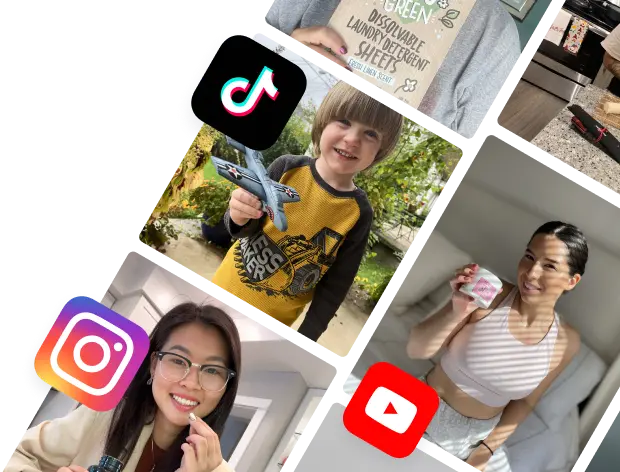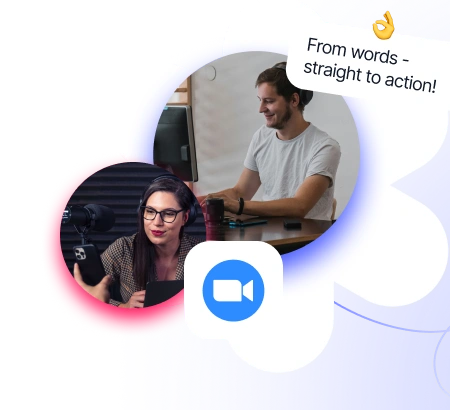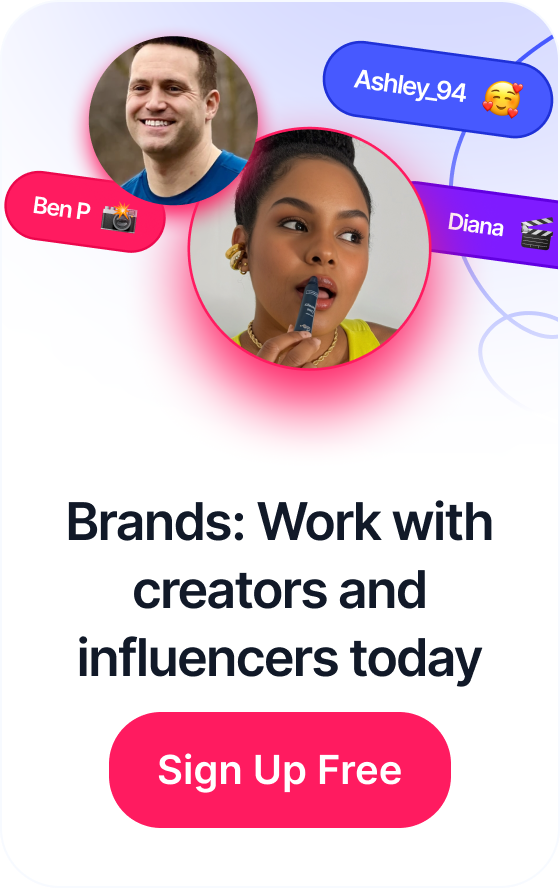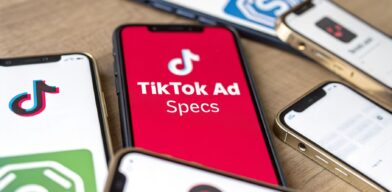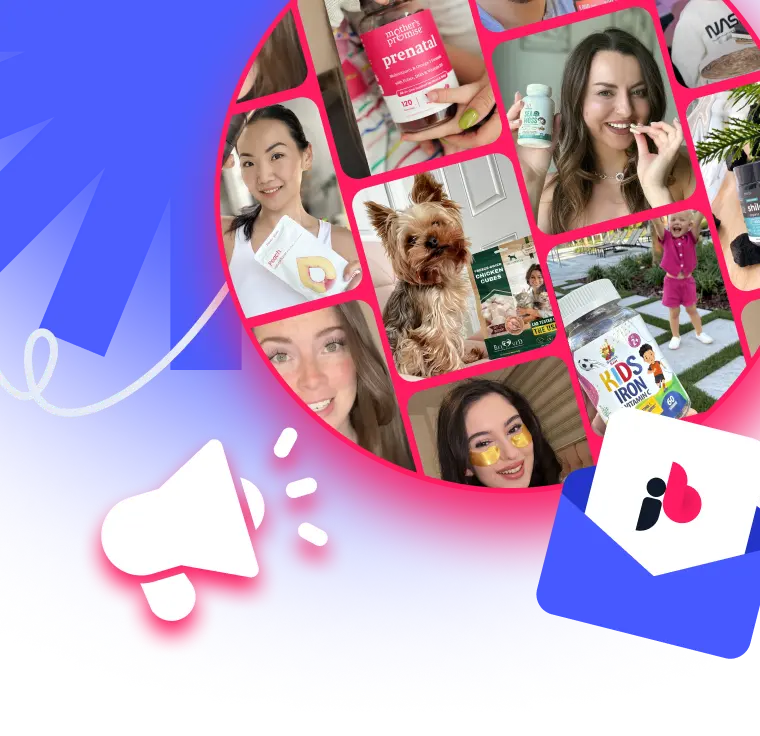 Top UGC Content Examples to Boost Your 2025 Strategy
Top UGC Content Examples to Boost Your 2025 Strategy
Before you even think about writing a blog post or hitting record on a video, you need a plan. A real one. Too many businesses dive headfirst into creating content without a clear direction, and that’s a recipe for wasted time and money. It's like building a skyscraper without a blueprint—the whole thing is bound to come tumbling down.
A solid content strategy connects every single thing you create back to what actually matters for your business. This is where we move past the fluff and get into real strategic thinking.
Define Your Core Business Objectives
First things first: what are you actually trying to accomplish? "Getting more traffic" isn't a goal; it's a wish. Your objectives need to be specific, measurable, and tied directly to business results. This objective becomes your North Star, guiding every decision you make from here on out.
Your goals will usually fall into one of these buckets:
- Brand Awareness: Getting your name in front of people who've never heard of you. You'll measure this with things like social media reach, share of voice, and direct traffic.
- Lead Generation: This is all about capturing contact info from potential customers. Think form submissions, email sign-ups, and landing page conversion rates.
- Customer Retention & Loyalty: Keeping the customers you already have happy and turning them into raving fans. Here, you’ll watch metrics like customer lifetime value (CLV), churn rate, and repeat purchases.
- Sales Enablement: Creating content that your sales team can use to close more deals. This is your arsenal of case studies, product comparisons, and detailed tutorials.
The sheer economic scale of this stuff shows why planning is so important. The global content marketing market is on track to hit $2 trillion by 2032. Plus, for 14% of marketers, content marketing brought in the highest ROI in 2023, and a staggering 80% of top-performing companies have a formal content strategy. These numbers aren't a coincidence; they prove that a well-thought-out plan is a serious financial driver.
Develop Deep Audience Understanding
Okay, you've got your goals. Now, who are you talking to? This is about more than just basic demographics like age or location. You need to dig deep and build out buyer personas that get into the psychology of your ideal customers.
A buyer persona is a semi-fictional representation of your ideal customer based on data and research. It’s not just a profile; it’s a tool for empathy that helps you understand what truly motivates, frustrates, and inspires your audience.
To build personas that actually work, you need to know:
- Pain Points: What problems are keeping them awake at night?
- Goals: What are they trying to achieve, both in their careers and personal lives?
- Watering Holes: Where do they hang out online? Is it LinkedIn, specific Reddit forums, or certain industry blogs?
- Triggers: What specific event or need makes them start searching for a solution like yours?
Talk to your current customers. Send out surveys. Creep on your social media comments. The better you know your audience, the more your content will feel like it was written just for them.
Establish Your Unique Brand Voice
Finally, what are you going to sound like? Your brand voice is your company's personality. In a sea of bland, corporate-speak, a distinct voice is what makes you stand out and stick in people's minds. It has to be consistent everywhere, from a 2,000-word blog post to a 280-character tweet.
A huge part of this is figuring out how you’ll show up on different channels. As you build out your foundation, you should also be developing a robust social media posting strategy to keep your presence consistent and effective.
Define your voice by picking a few core traits. Are you:
- Authoritative and buttoned-up?
- Witty and a little sarcastic?
- Genuinely helpful and empathetic?
- Inspirational and forward-thinking?
A clear brand voice builds trust and helps you cut through the noise, cementing your spot as a go-to authority in your space.
To tie this all together, here’s a look at how these foundational pieces fit into a cohesive strategy.
Core Components of a Content Strategy Foundation
| Component | Objective | Key Actions | Expected Outcome |
|---|---|---|---|
| Business Objectives | To align all content efforts with specific, measurable business outcomes. | Identify primary goals (e.g., awareness, lead gen, retention). Set clear KPIs for each goal. | A focused strategy where every piece of content has a clear purpose and contributes to business growth. |
| Audience Personas | To create content that deeply resonates with your ideal customer. | Conduct customer interviews, surveys, and market research. Identify pain points, goals, and online habits. | Highly relevant content that attracts the right audience and builds a strong, empathetic connection. |
| Brand Voice & Tone | To establish a consistent and memorable brand personality. | Define key personality traits (e.g., witty, authoritative). Create a style guide for internal use. | Increased brand recognition, trust, and a consistent customer experience across all platforms. |
Getting this foundation right is non-negotiable. It's the work you do upfront that ensures everything you create later on—from blog posts to videos to social media updates—works together to achieve your ultimate business goals.
Table of Contents
Building Your Content Creation Engine

Alright, you've got your goals and you know who you're talking to. Now for the fun part: actually making the content. This is where all those abstract ideas and audience personas start turning into real assets that work for your business.
We're moving beyond waiting for a stroke of genius. The goal here is to build a reliable engine—a repeatable system that churns out high-quality, valuable content consistently. This turns content creation from a chaotic, reactive mess into a predictable and scalable part of your marketing machine.
Start with Topic Clusters and Pillar Pages
One of the most powerful ways I've seen to organize content is the topic cluster model. Forget about one-off blog posts. This strategy is all about showing search engines (and your audience) that you're a true expert.
It works like this: you create a massive, comprehensive "pillar page" on a broad topic. Then, you create several more focused "cluster" pages on related subtopics, all linking back to that main pillar.
Think of an e-commerce brand that sells running shoes. Their pillar page might be "The Ultimate Guide to Running Shoes." From that hub, they'd link out to cluster content like:
- "How to Choose Running Shoes for Your Specific Foot Type"
- "Trail Running vs. Road Running Shoes: What's the Difference?"
- "The Top-Rated Running Shoes for Marathon Training"
- "Simple Ways to Care for Your Running Shoes and Make Them Last"
This structure doesn't just work wonders for your SEO authority; it creates a seamless journey for your audience, guiding them from general interest to specific, actionable answers.
Dig for Gold with Keyword Research
Good keyword research isn't just about chasing terms with high search volume. It's about getting inside your customer's head and understanding the intent behind their search. Are they just looking for information? Comparing their options? Or are they ready to pull out their credit card?
A killer tactic is to run a content gap analysis using a tool like Ahrefs or Semrush. This process shows you what keywords your competitors are ranking for that you aren't. It's a straight-up treasure map to high-intent topics your audience wants, but you haven't delivered on yet.
Pay special attention to long-tail keywords—those longer, more specific phrases of three or more words. They often signal that a user is much closer to making a decision.
A critical part of your strategy is deciding which content formats to focus on. Don't put all your eggs in one basket. For 45% of marketers, video is the top-performing content type. At the same time, a whopping 71% of consumers read at least one blog post during their buying journey. You can discover more trends in content marketing from recent studies to see what's working now.
This data just confirms what many of us have learned the hard way: a solid content strategy needs a mix of formats to connect with people wherever they are.
Create a Scalable Production Workflow
Whether you're a one-person show or leading a team of creators, you absolutely need a documented workflow. A clear, step-by-step process is the secret to maintaining quality and consistency, and it's what separates the pros from the amateurs.
Your workflow should map out every single stage, from the initial idea to the final promotion. A simple but incredibly effective process might look something like this:
- Idea Generation: The initial brainstorming and keyword research phase.
- Content Brief: Creating a detailed guide for the writer, including the topic, target keyword, audience, key points, and call-to-action.
- Drafting: The first pass at writing or creating the content.
- Editing & Review: A crucial step to check for grammar, style, and making sure it hits all the points in the brief.
- Design & Formatting: Adding visuals, breaking up text for readability, and optimizing for the web.
- Publication & Promotion: Hitting "publish" and kicking off your distribution plan.
Having a structured process like this ensures nothing slips through the cracks. It also makes it a breeze to bring on new writers or freelancers because your expectations are crystal clear from day one.
Finally, the editorial calendar is the tool that holds this all together. It's your command center. Using a tool like Asana, Trello, or even a well-organized spreadsheet, you can plan and schedule your content weeks or even months out. This guarantees a steady flow of value for your audience and, in turn, predictable results for your business.
How to Actually Use AI in Your Content Workflow
Let's be real. Artificial intelligence isn't some far-off concept from a sci-fi movie anymore. It’s here, and it's a ridiculously powerful assistant that can take your content workflow from a painful, slow grind to a high-speed operation.
The trick is to stop thinking of AI as a replacement for your creative team. Instead, think of it as a tireless intern. It handles the monotonous, soul-crushing tasks, freeing up your actual humans to do what they do best: high-level strategy, real creativity, and connecting with your audience.
The smartest way to weave AI into your content strategy is by using it to augment, not just automate. Its true power shines when you use it to speed up the research and drafting stages—the very parts of the process that eat up the most time. Making this shift lets your team produce better content, faster. That’s a serious competitive edge.
And this isn't just a small trend. It's a full-blown movement. The adoption rate of AI in marketing is staggering. As of 2025, over 80% of marketers globally are already using AI in their content strategies. That alone tells you how much of an impact it's having on both efficiency and creativity. You can see more stats on AI's role in content marketing over on Typeface.ai to get a sense of how big this really is.
Speed Up Ideation and Research with AI
One of the first places you'll feel AI's impact is in breaking through creative blocks. No more staring at a blinking cursor on a blank page. You can use AI tools to generate a mountain of solid ideas in just a few minutes.
Here are a few practical ways I’ve used AI for this:
- Brain-Dumping Topics: Feed an AI your main keyword, something like "sustainable fashion," and ask it for 50 blog post ideas. It’ll spit out a fantastic mix of angles, from "Beginner's Guides" to super-niche "How-To" articles you might not have considered.
- Spying on Competitors: Ask an AI assistant to analyze the top-ranking articles for your target keyword. It can instantly summarize their main points, outline their structure, and, most importantly, pinpoint the content gaps you can swoop in and fill.
- Mining for Audience Questions: This is a goldmine. Use AI to scrape forums like Reddit or Quora for the most common questions your target audience is asking. It's a direct line into their actual pain points.
This initial research grind, which used to take me hours of manual digging, can now be done in a fraction of the time. This lets you get to the fun part—actually creating the content—much faster.
Drafting Outlines and First Versions
Once your topic is locked in, AI is fantastic for building the skeleton of your article. By giving it a clear, detailed prompt—including your target keyword, who you're writing for, and the key points you want to hit—you can get a structured outline in seconds. This outline becomes a detailed roadmap for your writer, making sure all the important subtopics are covered right from the start.
AI should draft, but a human must finalize. The initial output from an AI is your starting block, not the finish line. The real magic happens when your team injects its expertise, unique insights, brand voice, and genuine stories.
For example, you could prompt an AI with something like: "Create a blog post outline for 'how to create a content marketing strategy,' specifically for small business owners. Make sure to include sections on goal setting, audience research, and content distribution." The AI will hand you a logical structure that your writer can then bring to life with real-world examples and your brand's unique perspective. For a deeper dive into how this all fits together, check out this great explainer on what is artificial intelligence in marketing.
Optimizing and Repurposing Content Like a Pro
Beyond just creating the first draft, AI is an absolute powerhouse for optimization and repurposing. It can scan your finished draft and suggest smart improvements you might have overlooked.
Here's how you can put it to work:
- Headline Brainstorming: Generate 20 different headline variations for your blog post. Then, run them through an AI-powered headline analyzer to see which one is most likely to get clicks.
- Quick SEO Wins: Ask an AI tool to review your article and suggest relevant secondary keywords, find opportunities for internal links, and give you tips to improve readability.
- Content Multiplication: This is my favorite. Feed a finished blog post into an AI tool and ask it to create a series of tweets, a LinkedIn post, and a script for a short video based on the content. You just multiplied the value of a single piece of content with minimal effort.
Amplifying Your Reach With Smart Distribution
Let's be honest. Creating brilliant content is only half the battle. If you fall into the “publish and pray” trap, even the most insightful article or jaw-dropping video will just sit there, gathering digital dust. An effective content marketing strategy needs a powerful, intentional distribution engine to get your hard work in front of the right eyeballs.
This is where you stop being just a content creator and start thinking like a savvy marketer. The goal isn't just to make stuff, but to build a system that maximizes the reach of every single asset, squeezing every last drop of value from your efforts.
Balancing Owned, Earned, and Paid Channels
A solid distribution strategy never puts all its eggs in one basket. Instead, it blends three different types of media to create a promotional machine. Each one plays a distinct and crucial role.
- Owned Media: These are the channels you control completely. Think of your company blog, your email list, and your social media profiles. This is your home turf, where you nurture a direct relationship with your audience.
- Earned Media: This is the digital version of word-of-mouth marketing. It’s what happens when others talk about you—mentions from the press, shares from influencers, guest posts on industry blogs, and organic social chatter. It's gold because it comes with built-in social proof.
- Paid Media: This is where you pay to get your content seen. This includes everything from social media ads and search engine marketing (PPC) to sponsored content. Paid channels are fantastic for laser-targeting specific demographics and guaranteeing your content reaches a new, relevant audience—fast.
The magic happens when you use all three in concert. You might publish a huge guide on your blog (owned), run targeted Facebook ads to a lookalike audience (paid), which then gets picked up and shared by an industry influencer (earned). That’s how you create momentum.
The Art of Content Repurposing
One of the biggest mistakes I see brands make is treating a piece of content as a one-and-done asset. To get the best ROI, you need to think like a content multiplier. A single, deeply researched pillar page can be sliced, diced, and re-imagined into dozens of smaller assets for different platforms.
This visual gives you a simple framework for auditing your content library. It helps you spot where you have strong coverage and where gaps exist that could be filled by new or repurposed content.
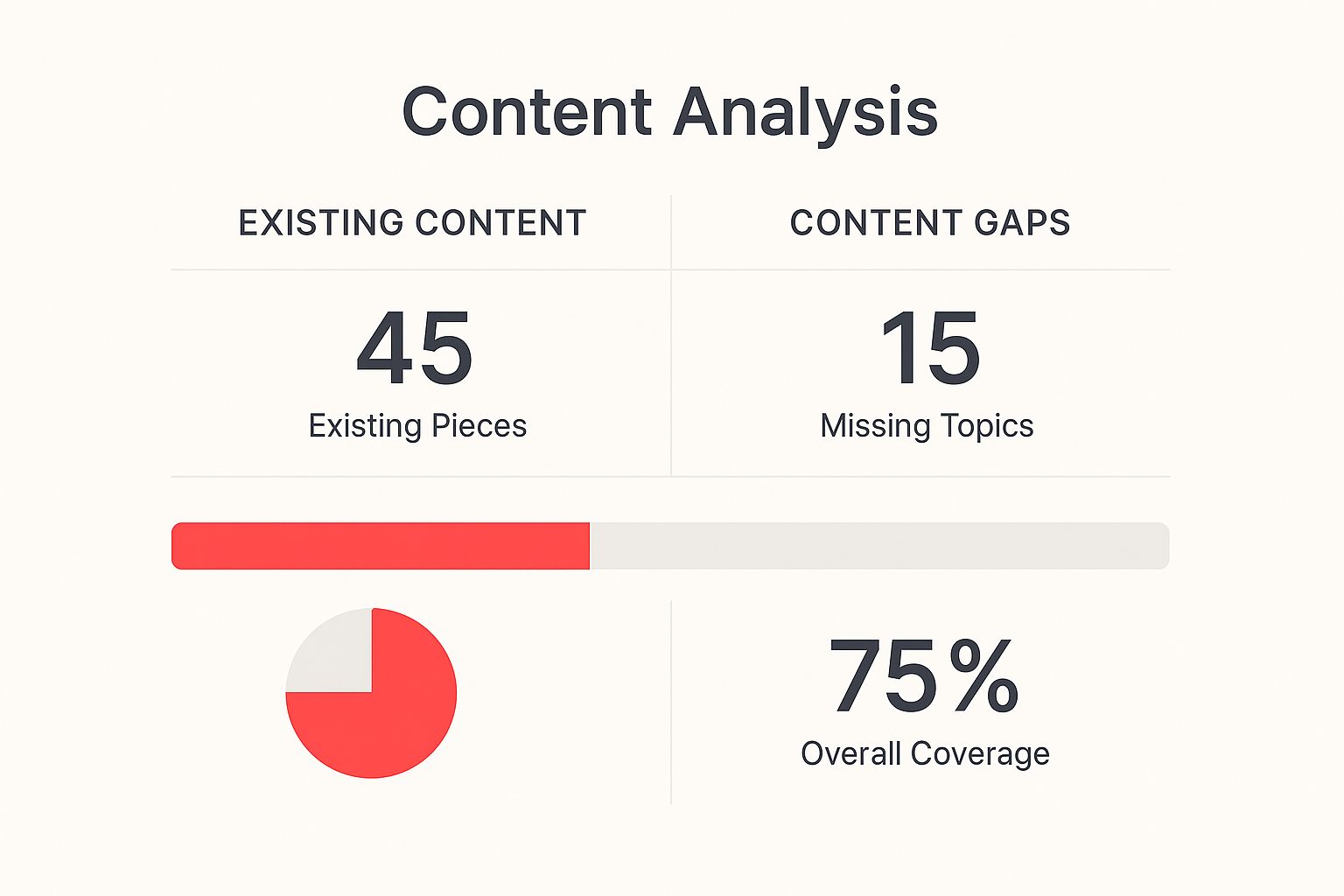
The real insight here is that you don't always need to start from scratch. Often, you can fill content gaps simply by transforming your existing high-performers into new formats.
For example, that 2,500-word guide you just published? It can also become:
- A 10-part email course
- An infographic summarizing the key stats
- A series of 5 short video clips for TikTok and Reels
- A detailed Twitter thread
- A presentation deck for SlideShare
This approach respects how different people prefer to consume information. Some love a long read, while others would rather watch a quick video. Repurposing ensures you meet them wherever they are.
Content Distribution Channel Comparison
To help you decide where to focus your efforts, it helps to compare the different channels at your disposal. Each has its own strengths and weaknesses.
| Channel Type | Examples | Pros | Cons |
|---|---|---|---|
| Owned Media | Company Blog, Email List, Social Profiles | Full control over content & messaging, builds direct audience relationships, cost-effective long-term. | Slow to build an audience from scratch, limited reach initially. |
| Earned Media | Press Mentions, Guest Posts, Influencer Shares, SEO | High credibility & trust, can drive significant organic traffic, cost-effective. | Unpredictable, hard to control the narrative, takes time to build relationships. |
| Paid Media | Social Media Ads, PPC, Sponsored Content, Native Advertising | Immediate reach, highly targeted, predictable and scalable results. | Can be expensive, ad fatigue is real, trust can be lower than organic. |
| Social & Community | Reddit, Quora, Facebook Groups, Slack Channels | Access to niche communities, authentic engagement, great for feedback. | Can be time-consuming, requires genuine participation (no spamming!). |
This table isn't about picking one "best" channel. It's about seeing how they fit together to create a comprehensive promotion strategy that covers all your bases.
Building Your Distribution Checklist
To make this process systematic, create a distribution checklist for every major piece of content you publish. This simple tool ensures nothing slips through the cracks and that you’re consistently squeezing every bit of potential out of your work. It turns promotion from an afterthought into a core part of your publishing workflow.
Your distribution strategy is what separates content that merely exists from content that actually performs. It’s the intentional effort after you hit "publish" that drives traffic, builds authority, and ultimately delivers business results.
This strategic push is only becoming more important. We're seeing a huge trend in marketing budgets shifting toward AI—not just for creating content, but for optimizing its distribution. For example, a recent study found 71% of marketers plan to invest at least $10 million into AI technologies over the next three years, and 83% of CMOs are optimistic about AI's role. If you want to dive deeper, you can check out the latest digital marketing statistics and insights from Marketing Dive. This just goes to show how central technology is becoming to getting your content seen.
Finally, never forget the human element. Build genuine relationships with partners, peers, and influencers in your space. Authentic amplification from a trusted source is more powerful than any ad you can buy. Offer them value first—share their content, engage with their posts, and look for collaborative opportunities. A strong network is your most valuable distribution asset, period.
Measuring Performance and Optimizing Your Strategy

A content marketing strategy isn’t something you can just "set and forget." Think of it as a living, breathing part of your business that needs constant attention and refinement to actually work. To turn your content from a hopeful expense into a predictable driver of growth, you need a continuous feedback loop where real data fuels your next moves.
This means you have to look past the ego-boosting (but often hollow) vanity metrics. Page views and social media likes feel good, sure, but they don't always translate to business impact. Instead, the real focus needs to be on Key Performance Indicators (KPIs) that connect directly back to the goals you set in the first place.
Focus on Metrics That Matter
To measure success accurately, you have to tie your tracking back to your core business objectives. It’s that simple. If your goal was lead generation, your most important metric isn't traffic; it's the conversion rate of your landing pages and the quality of leads you're pulling in. If brand awareness was the aim, you should be tracking things like share of voice, branded search volume, and organic traffic growth.
Here’s a quick breakdown of which KPIs to watch, based on what you're trying to achieve:
- For Lead Generation: Keep a close eye on form conversion rates, cost per lead (CPL), and lead-to-customer conversion rates. This tells you not just if you're getting leads, but if they're the right leads.
- For Brand Awareness: Monitor direct traffic, branded search queries, social media reach and engagement, and backlinks from reputable sites. These are all signs of your brand's growing footprint.
- For Customer Retention: Track metrics like repeat visitor rates, time on page for help articles, and customer churn. This data shows whether your content is actually supporting your existing customers.
Let's not forget how much social proof and partnerships play into this. With 76% of users influenced by social content when making purchases—and that number jumping to a staggering 90% for Gen Z—it's obvious these channels drive real action. It’s no surprise that 59% of marketers are planning to ramp up their influencer collaborations. For a deeper look, you can explore more insights on 2025 digital marketing trends from Marketing Dive.
Conduct Regular Content Audits
One of the most valuable things you can do is a regular content audit. This is just a systematic review of all your existing content to figure out what’s working, what’s failing, and where your biggest opportunities are.
Think of it as a health check-up for your entire content library. During an audit, you'll uncover:
- High-Performing Content: These are your rockstars. Find out why they resonate and figure out how to create more content just like them. Can you update or repurpose them?
- Underperforming Content: These pieces just aren't hitting the mark. You need to decide whether to update them with fresh info, combine them with other posts, or just delete them entirely.
- Content Gaps: Where are the holes in your topic clusters? An audit will shine a light on topics your audience is searching for that you haven’t even touched yet.
A content audit is your roadmap for optimization. It tells you exactly where to invest your resources for the highest return, ensuring you're not just creating more content, but creating smarter content.
A Framework for A/B Testing
Continuous optimization is built on testing. A/B testing, or split testing, is a simple but incredibly powerful way to improve performance over time. By testing one variable at a time, you can get crystal-clear data on what your audience actually responds to.
Start by testing the elements with the biggest potential impact. Here are a few ideas:
- Headlines: Test different styles. Pit a question-based headline against a direct, benefit-driven one and see which one wins.
- Calls-to-Action (CTAs): Experiment with the wording, color, and placement of your CTAs. Does "Get Your Free Guide" outperform "Download Now"? The only way to know is to test it.
- Content Formats: Test a classic blog post against a video or an infographic on the same topic. You might be surprised which format drives more engagement or conversions.
By consistently measuring what truly matters and using those insights to audit, test, and tweak your approach, you transform your content strategy from a static plan into a dynamic engine for sustainable business growth.
Got Questions About Content Strategy? We’ve Got Answers.

As you start putting all these pieces together, you're going to have questions. It's completely normal. Everyone hits these same roadblocks when they're first learning how to build a content marketing strategy.
Let's walk through some of the most common questions I hear and get you some clear, practical advice so you can keep moving forward.
How Much Should I Budget for Content Marketing?
Ah, the million-dollar question. While there's no single magic number, a solid starting point for most businesses is carving out 25-30% of your total marketing budget. If you're a startup trying to make a name for yourself, that number might need to be even higher.
But don't get hung up on a specific percentage. I always tell people to start with a foundational budget. Cover your non-negotiables first—your essential tools (like analytics software or a scheduler) and the cost to create that initial batch of pillar content.
Once you have content in the wild and start seeing a positive return on investment (ROI) from certain channels or formats, that's when you scale. This data-driven approach makes it a heck of a lot easier to walk into a stakeholder meeting and justify a bigger investment.
Think of your content budget less as a monthly expense and more as an investment in a long-term company asset. Truly great content appreciates over time, pulling in organic traffic and leads long after you hit "publish."
This little mindset shift changes the conversation from, "How much are we spending?" to "What's the long-term value we're building here?"
How Long Does It Take to See Results?
This is the big one, isn't it? The honest-to-goodness answer is that content marketing is a marathon, not a sprint. You might see some encouraging signs within the first 3 months—a bump in social engagement, a few new email subscribers—but the real, tangible results take time.
For needle-moving outcomes like a reliable flow of organic leads or a serious jump in search rankings, you’re usually looking at a 6 to 12-month runway.
Of course, that timeline depends on a few things:
- Your Industry: If you're in a crowded space, it's going to take more effort to cut through the noise.
- Your Quality & Consistency: Top-tier content published on a regular schedule will always speed things up.
- Your Promotion Game: How well you distribute your content is just as important as the content itself.
In the beginning, keep your eyes on leading indicators like keyword ranking improvements and upticks in website traffic. The lagging indicators, like qualified leads and actual sales, will follow as your efforts compound.
Content Strategy vs. Content Plan: What’s the Difference?
People use these terms interchangeably all the time, but they are two very different—though deeply connected—things. Getting this right is crucial for staying organized.
Here's the simplest way to think about it: it's the "why" versus the "what and how."
Your content strategy is your high-level "why." It's the blueprint. This document outlines your core goals, who you're talking to, your unique voice, and what problems you're solving. It's your north star, and it doesn't change much.
Your content plan, on the other hand, is the tactical "what," "when," and "where." This is your editorial calendar, your Trello board—it lists the specific blog posts, videos, and social campaigns you're going to create. A plan is nimble; it should evolve based on what the data tells you.
You can't have a good plan without a solid strategy guiding it. And a strategy is just a nice-looking document without a plan to actually bring it to life.
Should I Focus on Quality or Quantity?
Back in the early days of content marketing, you could win by just pumping out more content than the other guy. Not anymore. Today, the answer is crystal clear: quality first, then consistent quantity.
One truly exceptional, deeply researched article that genuinely helps your audience will do more for you than ten thin, generic blog posts ever could. Your first job is to create the absolute best resource on a topic for your target reader. Period.
Once you’ve got a process for creating that high-quality work, then you can focus on building a sustainable publishing cadence. The goal is to find that sweet spot where you're producing fantastic content regularly without burning out or letting the quality slip. Don't just add to the noise online; be the signal.
Ready to put these strategies into action and connect with creators who can bring your vision to life? JoinBrands is an all-in-one platform that links you with over 250,000 creators, from TikTok Shop affiliates to UGC producers. Streamline your entire campaign workflow, from AI-powered creator matching to content approval and ad activation, all in a single interface. Start accelerating your brand's growth with JoinBrands today.

